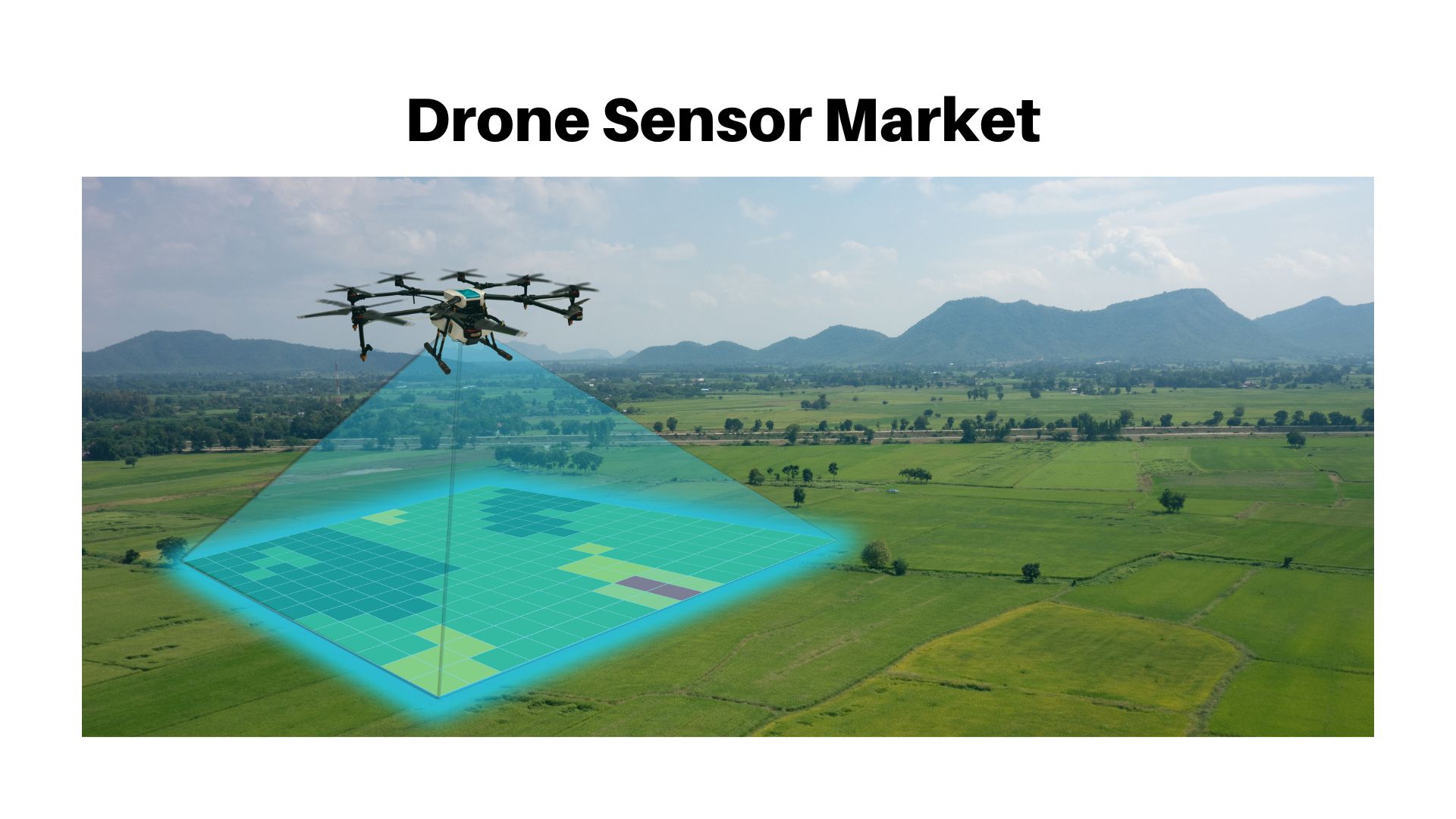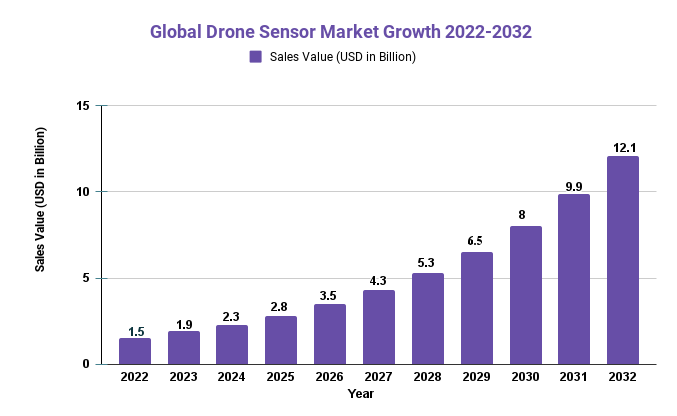Drone Sensor Market is Estimated to Showcase Significant Growth of USD 12.1 Bn in 2032 With a CAGR 23%

Page Contents
Market Overview
Published Via 11Press: The Drone Sensor Market has seen tremendous growth in recent years due to an uptick in demand for unmanned aerial vehicles (UAVs) across a variety of industries. Drone sensors are essential components of UAVs, providing data and information that enables drones to perform various tasks such as aerial photography and surveying, search-and-rescue missions, and military surveillance missions.
Drone Sensor Market is projected to grow from USD 1.5 billion in 2022 to USD 12.1 billion by 2032, at an annual compound growth rate (CAGR) of 23% during the forecast period. This growth is being fuelled by factors such as increasing drone adoption across various industries, advances in sensor technologies, and the emergence of new applications for drone sensors.
The military and defense sector has been the largest end-user of drone sensors, accounting for a substantial share of the market. However, commercial applications are expected to experience significant growth over the coming years due to the growing adoption of drones in mapping/surveying, agriculture, and delivery services.
In terms of sensor types, the market is divided into inertial sensors, image sensors, speed and distance sensors, temperature sensors, pressure sensors, and others. Image sensors are expected to lead the market during the forecast period due to their widespread usage in aerial photography and videography applications.
Drivers, trends, and challenges have an impact on market dynamics, which can impact businesses. Request for PDF sample report

Key Takeaways
- The Drone Sensor Market is projected to grow from USD 1.5 billion in 2022 to USD 12.1 billion by 2032, at a compound annual growth rate (CAGR) of 23% during the forecast period.
- Image sensors are projected to remain the dominant market segment throughout the forecast period, due to their extensive usage in aerial photography and videography applications.
- The commercial sector is expected to experience tremendous growth over the coming years, due to the increasing use of drones for mapping and surveying, agriculture, and delivery services.
- North America is expected to be the leading market for drone sensors, followed by Europe and Asia-Pacific.
Regional Overview
- North America is expected to be the leading market for drone sensors, due to the presence of several key players and high adoption of UAVs both for military and commercial applications.
- Europe is a key market for drone sensors, thanks to several established players and the growing adoption of UAVs across various industries.
- The Asia-Pacific region is expected to experience significant growth during the forecast period, driven by increasing investment in drone technology by countries such as China and India, along with expanding adoption of UAVs across various industries.
- The Middle East and Africa region is expected to experience moderate growth over the coming years due to increasing adoption of UAVs for military and commercial uses.
Drivers
- Drone adoption is increasing across various industries, such as military, agriculture, surveying, and inspection; all of which require drone sensors for data collection and analysis.
- Thanks to advances in sensor technologies such as miniaturization, improved accuracy, and enhanced functionality, drone sensors have become more efficient and reliable than ever before.
- Drone sensors are being increasingly utilized for new and innovative purposes such as environmental monitoring, disaster response, and delivery services – which is expected to further fuel demand for drone sensors in the future.
- Government and private companies are investing more heavily in drone technology, which is expected to spur innovation and lead to the creation of superior drone sensors.
Restraints
- Government regulations regarding drone usage could limit their adoption in some regions.
- Privacy and security concerns associated with drone technology could deter some potential customers from adopting this technology.
- Due to their high cost, drone sensors may not be cost-effective for smaller companies and organizations. Furthermore, drones only have a limited flight range and battery life which may impact their effectiveness in certain applications.
Opportunities
- Drone adoption for inspection and monitoring applications such as infrastructure inspection, environmental monitoring, and wildlife conservation is on the rise, necessitating drone sensors for data collection and analysis.
- Integration of artificial intelligence and machine learning technologies with drone sensors is expected to enable more complex, automated data processing and analysis.
- Drone sensors have the potential to enable new and innovative uses, such as medical delivery or telepresence, which could provide lucrative new business opportunities in the future.
- The growing demand for lightweight and compact drone sensors could present sensor manufacturers with an opportunity to develop novel, cutting-edge products.
Challenges
- Regulations related to drone usage and airspace management could limit its adoption in certain regions.
- Furthermore, intense competition within the drone sensor market could limit profitability for some manufacturers.
- Drones typically have limited flight range and battery life, which could limit their effectiveness in certain applications.
- Furthermore, lacking qualified personnel to operate and maintain drone systems may prevent certain organizations from adopting them.
Recent developments
- In March 2021, drone sensor manufacturer, Aerotenna, launched a new radar sensor for drones, which is designed to provide high-precision altitude and distance measurements in challenging environments, such as indoors or in adverse weather conditions.
- In February 2021, FLIR Systems, a sensor technology company, announced the launch of its new drone sensor, the FLIR Vue TZ20, which is designed for professional drone operators and provides high-resolution thermal imaging and visible light video recording.
- In January 2021, DJI, a leading drone manufacturer, launched a new drone sensor, the DJI Air 2S, which features a 1-inch CMOS sensor and is designed for professional photographers and videographers.
Key Market Segments
Type
- Inertial Sensors (Accelerometers, Gyroscope, Magnetometers, Tilt)
- Image Sensors (Infrared, Thermal, Multispectral, 3D)
- Speed and Distance Sensors (Radar, LiDAR, Proximity)
- Position Sensors (GPS, GNSS)
- Pressure Sensors (Barometric, Differential)
- Current Sensors
- Ultrasonic Sensors
- Light Sensors
- Altimeter Sensors
Application
- VTOL Platform
- Fixed Wing Platform
- Hybrid Platform
Key Market Players
- TE Connectivity
- Raytheon
- Trimble
- TDK Invensense
- Sparton Navex
- Bosch Sensortec
- Flir Systems
- KVH Industries
- AMS AG
- Lord Microstrain
- Systron Donner Inertial
- Leddartech
- Yost Labs
- SBG Systems
- Velodyne LiDAR
- Sony Semiconductor Solution
- Questuav
- Sensirion
- UTC Aerospace Systems
- Aerotenna
Report Scope
| Report Attribute | Details |
| The market size value in 2022 | USD 1.5 Bn |
| Revenue forecast by 2032 | USD 12.1 Bn |
| Growth Rate | CAGR Of 23% |
| Regions Covered | North America, Europe, Asia Pacific, Latin America, and Middle East & Africa, and Rest of the World |
| Historical Years | 2017-2022 |
| Base Year | 2022 |
| Estimated Year | 2023 |
| Short-Term Projection Year | 2028 |
| Long-Term Projected Year | 2032 |
Frequently Asked Questions
Q: What are drone sensors used for?
A: Drone sensors are used for collecting data and information that enable drones to perform various tasks, such as aerial photography, surveying, search and rescue operations, and military surveillance.
Q: What are the different types of drone sensors?
A: The different types of drone sensors include inertial sensors, image sensors, speed and distance sensors, temperature sensors, pressure sensors, and others.
Q: What are some of the challenges facing the drone sensor market?
A: Some of the challenges facing the drone sensor market include regulatory challenges related to drone usage, high competition in the market, limited flight range and battery life of drones, and limited availability of skilled personnel to operate and maintain drone systems.
Q: Which region is expected to be the largest market for drone sensors?
A: North America is expected to be the largest market for drone sensors, followed by Europe and Asia-Pacific.
Q: What are some of the opportunities for the drone sensor market?
A: Some of the opportunities for the drone sensor market include increasing adoption of drones for inspection and monitoring applications, integration of AI and machine learning technologies with drone sensors, and development of new and innovative applications for drone sensors.
The team behind market.us, marketresearch.biz, market.biz and more. Our purpose is to keep our customers ahead of the game with regard to the markets. They may fluctuate up or down, but we will help you to stay ahead of the curve in these market fluctuations. Our consistent growth and ability to deliver in-depth analyses and market insight has engaged genuine market players. They have faith in us to offer the data and information they require to make balanced and decisive marketing decisions.